Analysis of the Causes of Traffic Accidents and Identification of Accident-Prone Points in Long Downhill Tunnel of Mountain Expressways Based on Data Mining
Abstract
:1. Introduction
2. Data Characteristics and Test Methods
2.1. Traffic Accident Data Characteristics and Data Mining of Long Downhill Tunnels of Mountain Expressways
2.2. Accident Cause Analysis Method Based on the Decision Tree Model
2.3. Identification of Traffic Accident-Prone Points Based on Improved Cumulative Frequency Curve Method
2.4. Technical Map
3. Results
3.1. Distribution Characteristics of Traffic Accidents in the Long Downhill Tunnel of Mountain Expressways
3.1.1. Time Distribution Characteristics of Traffic Accidents
- Monthly distribution characteristics of accidents.
- 2.
- Weekly average daily distribution characteristics of accidents.
- 3.
- Hourly distribution characteristics of accidents.
3.1.2. Spatial Distribution Characteristics of Accidents
- (1)
- Accidents in the Baoding section of Zhangshi Expressway were densely distributed in Section 4, accounting for 46.67% of the entire section. The primary reason was that the length of the tunnel in this section was too long, causing the driver to drive in an extremely monotonous driving environment for a long time, which can easily affect the driver’s vision and psychological state, resulting in traffic accidents.
- (2)
- From the overall analysis results, it may be concluded that the accident frequency in Section 1 and Section 3 was much higher than the overall average level, particularly in Section 1; the accident frequency was 2 to 4 times that of other sections. As there was a large difference in illuminance inside and outside the tunnel when the vehicle passed through the entrance and exit area of the tunnel, the driver was affected by the “black hole” and “white hole” effect, and there was a short exclusion stage for the sudden change of illuminance, resulting in the loss of line of sight and the inability to receive external environmental information in a short time. Concurrently, due to the influence of the environment, there was a sudden change in the pavement properties at the tunnel entrance and exit, and there was a large difference in the adhesion coefficient between adjacent pavements. The driver may have lost control of the vehicle due to the sudden change of pavement properties, resulting in the phenomenon of a vehicle skidding.
- (3)
- From the data of Zijingguan tunnel 1, Yunmengshan tunnel 1 and other sections, it can be observed that with the increase of the length of the tunnel itself, the number of accidents demonstrates a slight downward trend, but when the length of the tunnel increases to more than 2000 m, the number of accidents demonstrates a significant upward trend.
3.1.3. Form Distribution Characteristics of Accidents
3.1.4. Vehicle Types Distribution Characteristics of Accident
- (1)
- Cars and trucks accounted for the largest proportion of vehicle types in the overall traffic volume;
- (2)
- The speed difference between cars and trucks was obvious, and the speed distribution was relatively discrete, which further leads to an increase in the number of traffic accidents;
- (3)
- Large trucks, particularly extra-large trucks, were mostly overloaded and were prone to traffic accidents.
3.1.5. Alignment Distribution Characteristics of Accident Roads
- Longitudinal alignment distribution characteristics of the traffic accident in the long downhill tunnel of mountain expressways
- 2.
- Plane linear distribution characteristics of the traffic accidents in the long downhill tunnels of mountain expressways
3.2. Analysis on the Causes of Accidents in Long Downhill Tunnels of Mountain Expressways
3.2.1. Data Preprocessing
3.2.2. Analysis of Accident Causes Based on Decision Tree Model
- (1)
- Since the Zhangshi Expressway is located in a mountainous area, and most of it is a long downhill tunnel section, with a unique structure and special curvature. Two factors, the radius of the horizontal curve and the length of the slope, will have a very important impact on the accident.
- (2)
- The object of this data mining was the Baoding section of the Zhangshi Expressway. As the second passage of the Jingshi Expressway, the Zhangshi Expressway bears the great responsibility of diverting the Jingshi Expressway. According to the survey data, the difference in passenger and cargo flow from Monday to Thursday was small, but with the holiday of Saturday, Sunday and other holidays, many passenger and cargo vehicles had to leave Beijing through this road, so the activity of people and vehicles had increased, the overall traffic volume and the frequency of traffic accidents also increased accordingly. Therefore, the day of the week had a great influence on the probability of traffic accidents;
- (3)
- As the Zhangshi Expressway is located in a long downhill section in the mountainous area, the road is often downhill and the distance is long, and the road conditions are undulating and changing. For the driver of the vehicle, frequent braking arrangements were required to prevent the danger of an accident due to excessive speed. However, due to the large volume and gravity of the large vehicle itself, frequent use of the braking device would cause the temperature of the brake hub to increase rapidly. In a short period, it may sometimes rise to 400 to 500 °C, which would cause the temperature of the brake hub to be too high and the braking measures would fail, resulting in traffic accidents. Therefore, the frequency of accidents of large vehicles had a large impact on the increase in the number of traffic accidents on the entire Zhangshi Expressway.
3.3. Identification of Accident-Prone Points in Long Downhill Tunnels of Mountain Expressways
- 1.
- Take the death weight as 2.0 and the injury weight as 1.5.
- 2.
- Using 1 km as the length standard, and using the traffic accident data of Zhangshi Expressway from 2013 to 2018, the number of equivalent accidents and the equivalent accident rate of the Baoding section of Zhangshi Expressway were calculated.
4. Conclusions
- In the time distribution characteristics of traffic accidents, the frequency of accident distribution was the largest in June, which was the peak value, and the frequency of distribution was the smallest in January, which was the trough value, and the frequency of accidents from January to June indicated an increasing trend. The accident frequency was the highest on Saturdays and Sundays. The times of 4:00 to 6:00, 13:00 to 16:00, 17:00 to 19:00, and 23:00 to 1:00 were the accident peaks, and these four time periods accounted for 54.38% of the total number of traffic accidents. In the spatial distribution characteristics of accidents, the length of the tunnel had a significant influence on the occurrence of traffic accidents. In the form distribution characteristics of accidents, the traffic accident patterns mainly indicated collisions with moving vehicles and collisions with stationary vehicles, accounting for 54.73% and 28.96%, respectively. In the vehicle-type distribution characteristics of the accident, small passenger cars and large trucks accounted for the highest proportion of accident models, which were 34.37% and 54.37%, respectively. In the alignment distribution characteristics of accident roads, when the slope was −3% to −2%, the accident rate was the largest, accounting for 42% of all accidents. When the radius of the flat curve was greater than 3000 m, the chance of traffic accidents increased rapidly, therefore, the radius of the horizontal curve should not exceed 3000 m.
- Using the accident attribute in the characteristic variable set of expressway traffic accidents as the independent variable and the maximum injury degree as the target attribute, a decision tree model was constructed to analyze the cause of traffic accidents. The overall confidence level of the decision tree model was 70.7%, which was a good assimilation of the database data and can well derive the significant correlation factors affecting the severity of the accident. The research indicates that the radius of the horizontal curve, week, slope length, time, and truck ratio was significantly related to the occurrence of traffic accidents in the long downhill tunnel of the expressway in the mountainous area.
- The identification of accident-prone points was performed using the improved cumulative frequency curve method. Based on the accident investigation data of the Baoding section of the Zhangshi Expressway, the cumulative frequency of the long downhill tunnel section of the mountain expressways was obtained. Using the equivalent accident numbers and equal to 80% and 95% as critical values, the accident-prone points and the potential accident-prone points of this road section were calculated and obtained. The total length of accident-prone points and potential accident-prone points in the Baoding section of Zhangshi Expressway were 6 km and 22 km, respectively, and accounted for 6.98% and 25.58% of the total length, respectively.
Author Contributions
Funding
Data Availability Statement
Conflicts of Interest
References
- Costa, A.; Figueira, A.; Larocca, A. An eye-tracking study of the effects of dimensions of speed limit traffic signs on a mountain highway on driver perception. Transp. Res. Part F Traffic Psychol. Behav. 2022, 87, 42–53. [Google Scholar] [CrossRef]
- Tang, Y.; Peng, X.; Xu, S.; Bai, M.; Lin, L.; Sun, H. Study on Driver Gaze Characteristics in Sight Distance Limited Section of Mountain Highway Based on Visual Information. J. Math. 2022, 2022, 9482875. [Google Scholar] [CrossRef]
- Xie, S.; Ji, X.; Yang, W.; Hu, C. Analysis of Traffic Accident Characteristic and Difference in Two-Lane Plateau Mountain Highways. In Proceedings of the 20th COTA International Conference of Transportation Professionals, Xi’an, China, 14–16 August 2020. [Google Scholar]
- Men, Y.Z.; Yu, H.B.; Wang, H.; Xu, L. Study on Driving Deceleration Model on Horizontal Curve Sections of Mountain Highways. Adv. Mater. Res. 2012, 479–481, 1660–1664. [Google Scholar] [CrossRef]
- Wen, Z.; Zhang, H.; Zhang, R. Safety-Critical Event Identification on Mountain Roads for Traffic Safety and Environmental Protection Using Support Vector Machine with Information Entropy. Sustainability 2021, 13, 4426. [Google Scholar] [CrossRef]
- Zhou, H. Research on Prevention and Control Countermeasures to Traffic Accident in Long and Deep Downhill Section of Mountainous Highways. Munic. Eng. Technol. 2011, 29, 22–25. [Google Scholar]
- Wang, F.; Gu, D.; Li, Y.; Liu, W.; Wang, G.; Ding, N. Effects of Visual Active Deceleration Devices on Controlling Vehicle Speeds in a Long Downhill Tunnel of an Expressway. Appl. Sci. 2021, 11, 6753. [Google Scholar] [CrossRef]
- Ying, L.; Qin, W.; Liu, X. Safety Evaluation and Remediation Measures Research for Continuous Long Downhill Segment in Expressway. West. China Commun. Sci. Technol. 2013, 6, 8–13. [Google Scholar]
- Ding, Y.; Li, D.; Huang, M.; Cao, X.; Tang, B. Study on the influence of skid resistance on traffic safety of highway with a high ratio of bridges and tunnels. Transp. Saf. Environ. 2021, 3, tdab025. [Google Scholar] [CrossRef]
- Zhou, R.; Wang, Y. Modeling Fire Site Location Considering Traffic Accident Characteristics in Mountainous Expressway. In Proceedings of the 2018 International Conference on Transportation & Logistics, Information & Communication, Smart City (TLICSC 2018), Chengdu, China, 30–31 October 2018. [Google Scholar]
- Zou, Y.; Zhang, Y.; Cheng, K. Exploring the Impact of Climate and Extreme Weather on Fatal Traffic Accidents. Sustainability 2021, 13, 390. [Google Scholar] [CrossRef]
- Gang, M.; Yan, D. Traffic Accident Analysis and Prevention Measures for Long Downhill Stretch of Highway. Highway 2017, 62, 143–146. [Google Scholar]
- Hasegawa, H.; Arimura, M.; Fujii, M.; Tamura, T. A basic study on traffic accident data analysis using support vector machine. In Proceedings of the Eastern Asia Society For Transportation Studies; Eastern Asia Society for Transportation Studies: Tokyo, Japan, 2007; p. 369. [Google Scholar]
- Xi, J.; Gao, Z.; Niu, S.; Ding, T.; Ning, G. A Hybrid Algorithm of Traffic Accident Data Mining on Cause Analysis. Math. Probl. Eng. 2013, 2013, 130–137. [Google Scholar] [CrossRef]
- Martin, J.L.; Gadegbeku, B.; Wu, D.; Viallon, V.; Laumon, B. Cannabis, alcohol and fatal road accidents. PLoS ONE 2017, 12, e0187320. [Google Scholar] [CrossRef] [PubMed]
- Selvaraj, S. Feature Relevance Analysis and Classification of Road Traffic Accident Data through Data Mining Techniques. In Proceedings of the IAENG-World Congress on Engineering and Computer Science, San Francisco, CA, USA, 24–26 October 2012. [Google Scholar]
- Feng, H. Traffic Accident Characteristics and Mechanism Analysis of Mountain Highway Tunnel Group. Highway 2016, 61, 134–138. [Google Scholar]
- Fang, Q.; Pan, X.; Wen, Y. Study on Early-warning Algorithm of Freeway Traffic Accident Based on Associative Data Mining. Highw. Eng. 2012, 37, 113–115+121. [Google Scholar]
- Wu, H.; Guo, L. Data mining model of the road traffic accident based on association rules. Appl. Electron. Tech. 2009, 2, 135–138,142. [Google Scholar]
- Yanbin, Y.; Lijuan, Z.; Mengjun, L.; Ling, S. Early Warning of Traffic Accident in Shanghai Based on Large Data Set Mining. In Proceedings of the 2016 International Conference on Intelligent Transportation, Big Data & Smart City (ICITBS), Changsha, China, 17–18 December 2016. [Google Scholar]
- Zhang, X.; Fan, L. A decision tree approach for traffic accident analysis of saskatchewan highways. In Proceedings of the 26th IEEE Canadian Conference on Electrical and Computer Engineering (CCECE), Regina, SK, Canada, 5–8 May 2013. [Google Scholar]
- Li, J.; Zhang, G.; Ren, H.; Dong, B.; Chen, F. Traffic Accident Characteristics of Long-span Estuary Bridges:an Analysis of Shanghai Yangtze River Tunnel-Bridge. China Transp. Rev. 2019, 41, 18–23+70. [Google Scholar]
- Wang, B. The Traffic Accident Characteristics Analysis of Highway Tunnel. Traffic Transp. 2012, 7, 164–167. [Google Scholar]
- Zhou, J.; Wang, J.; Lu, L. Research on Statistical Analysis of Traffic Accident Characteristics in the Urban River-crossing Tunnel. Commun. Shipp. 2019, 6, 75–79. [Google Scholar]
- Takahiro, T.; Toshio, Y.; Jian, X. Study on Accident Risk considering Traffic States and Road Geometry in Intercity Expressways. Jste J. Traffic Eng. 2019, 5, A-199–A-207. [Google Scholar]
- Ma, Z.; Fang, S.; Liu, S.; Cai, B. Analysis of the Relationship between the Number of Traffic Accidents and the Traffic Flow & Section Location in Extra Long Tunnel. Engineering 2020, 12, 71. [Google Scholar]
- Zheng, Y.Y.; Mei, Y. Analysis of Influencing Factors of Traffic Accidents in Undersea Tunnel. J. Eng. Res. Rep. 2020, 15, 37–49. [Google Scholar] [CrossRef]
- Li, Z.; Xing, G.; Zhao, X.; Li, H. Impact of the connected vehicle environment on tunnel entrance zone. Accid. Anal. Prev. 2021, 157, 106145. [Google Scholar] [CrossRef] [PubMed]
- Hassan, A.; Sturgess, C. Road Traffic Accident Data Collection and Analysis for Road Safety Research. In Proceedings of the 4th International Forum of Traffic Safety, Changsha, China, 25 November 2005. [Google Scholar]
- Rogalewicz, M.; Sika, R. Methodologies of Knowledge Discovery from Data and Data Mining Methods in Mechanical Engineering. Manag. Prod. Eng. Rev. 2016, 7, 97–108. [Google Scholar] [CrossRef] [Green Version]
- Shiran, G.; Imaninasab, R.; Khayamim, R. Crash Severity Analysis of Highways Based on Multinomial Logistic Regression Model, Decision Tree Techniques, and Artificial Neural Network: A Modeling Comparison. Sustainability 2021, 13, 5670. [Google Scholar] [CrossRef]
- Santos, V.B.; Pires, C.E.S.; Nascimento, D.C.; de Queiroz, A.R.M. A Decision Tree Ensemble Model for Predicting Bus Bunching. Comput. J. 2021. [Google Scholar] [CrossRef]
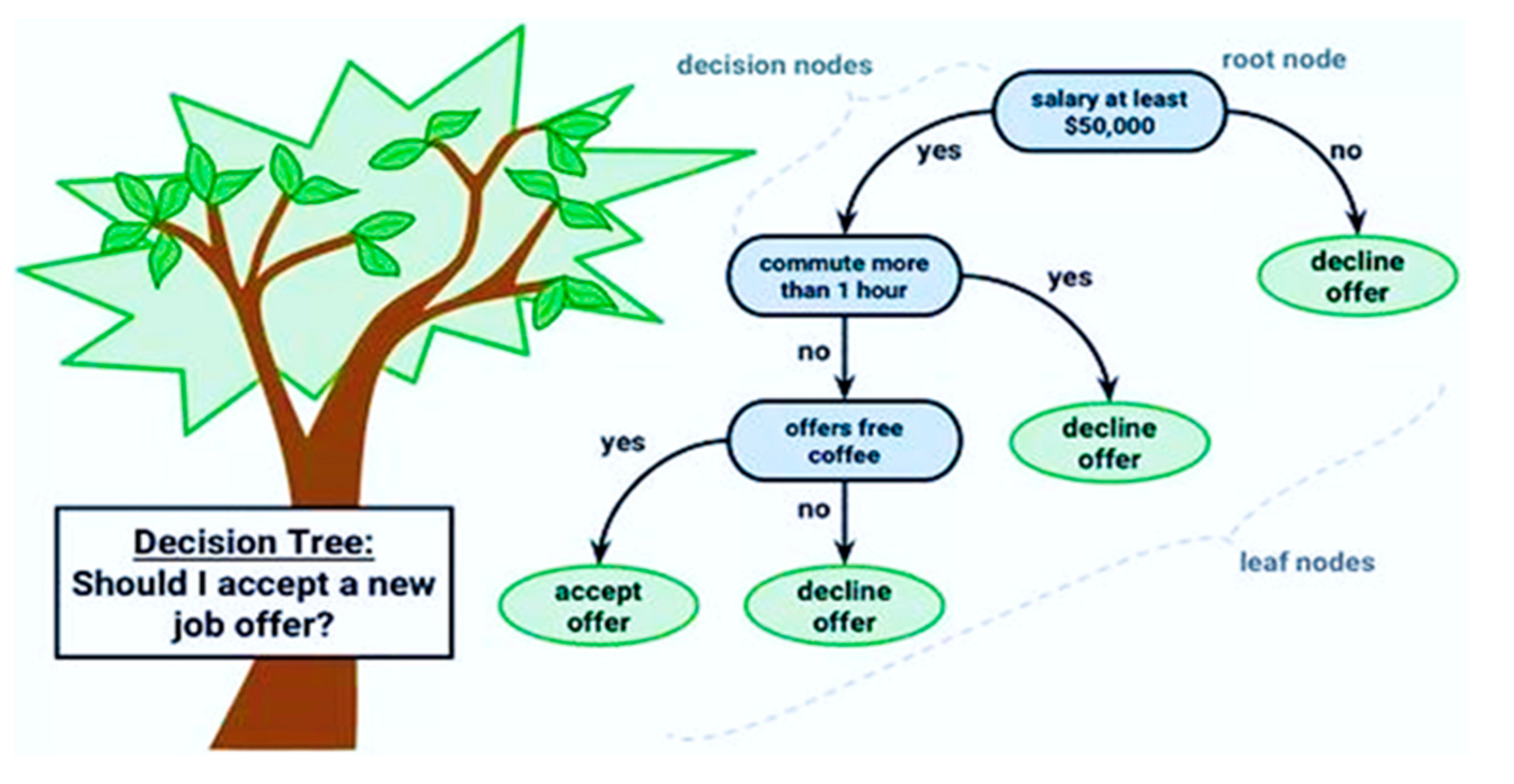

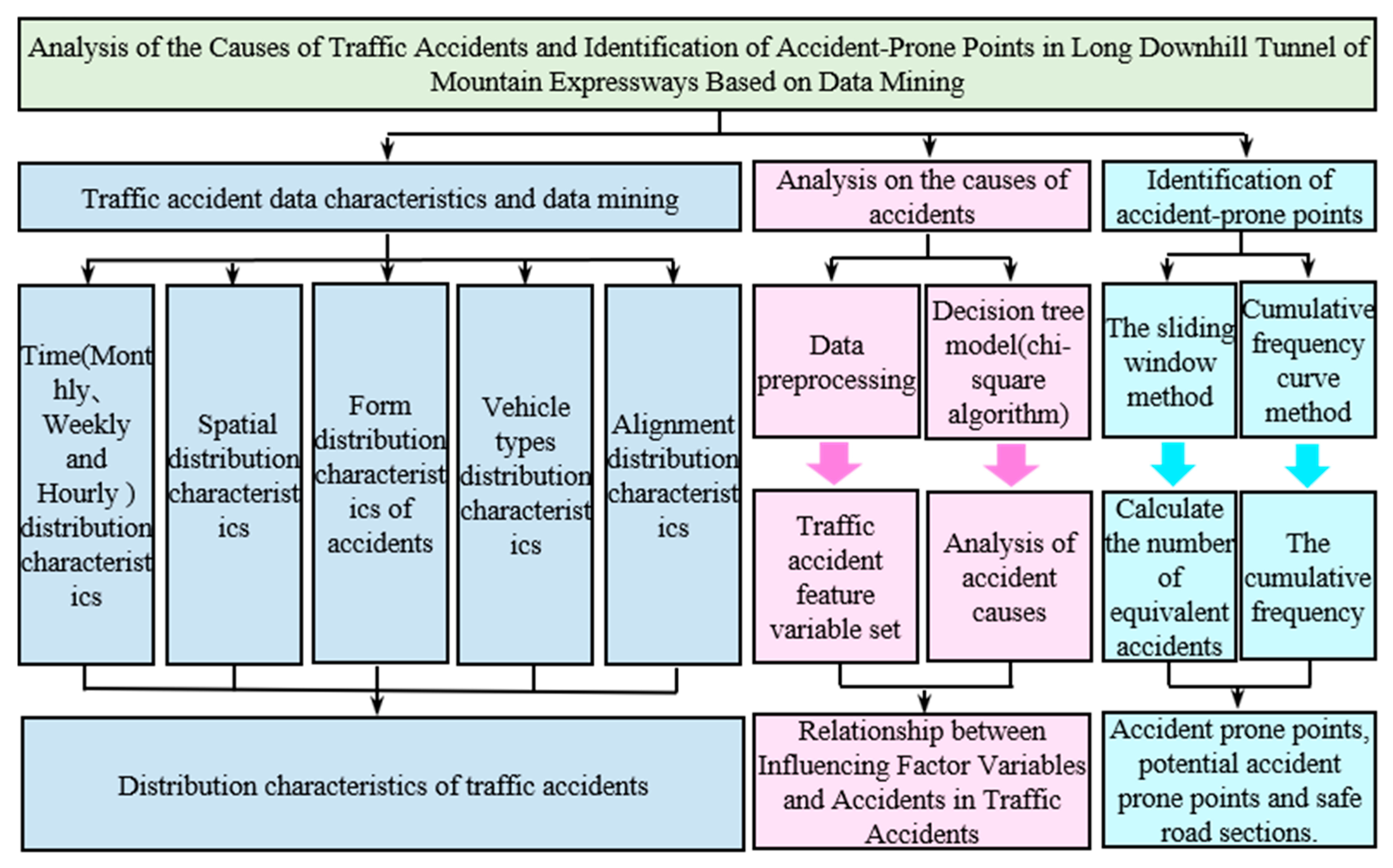
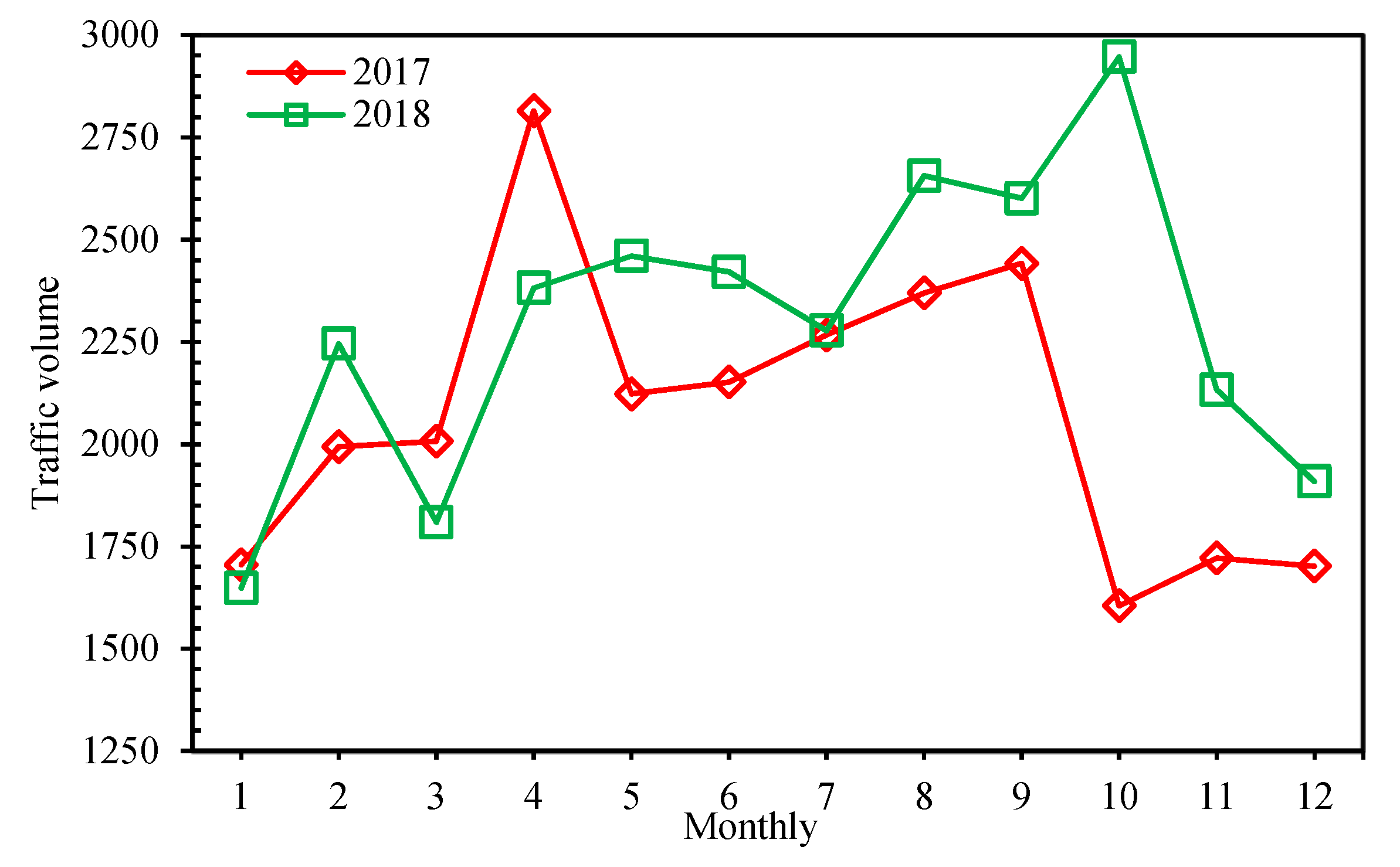

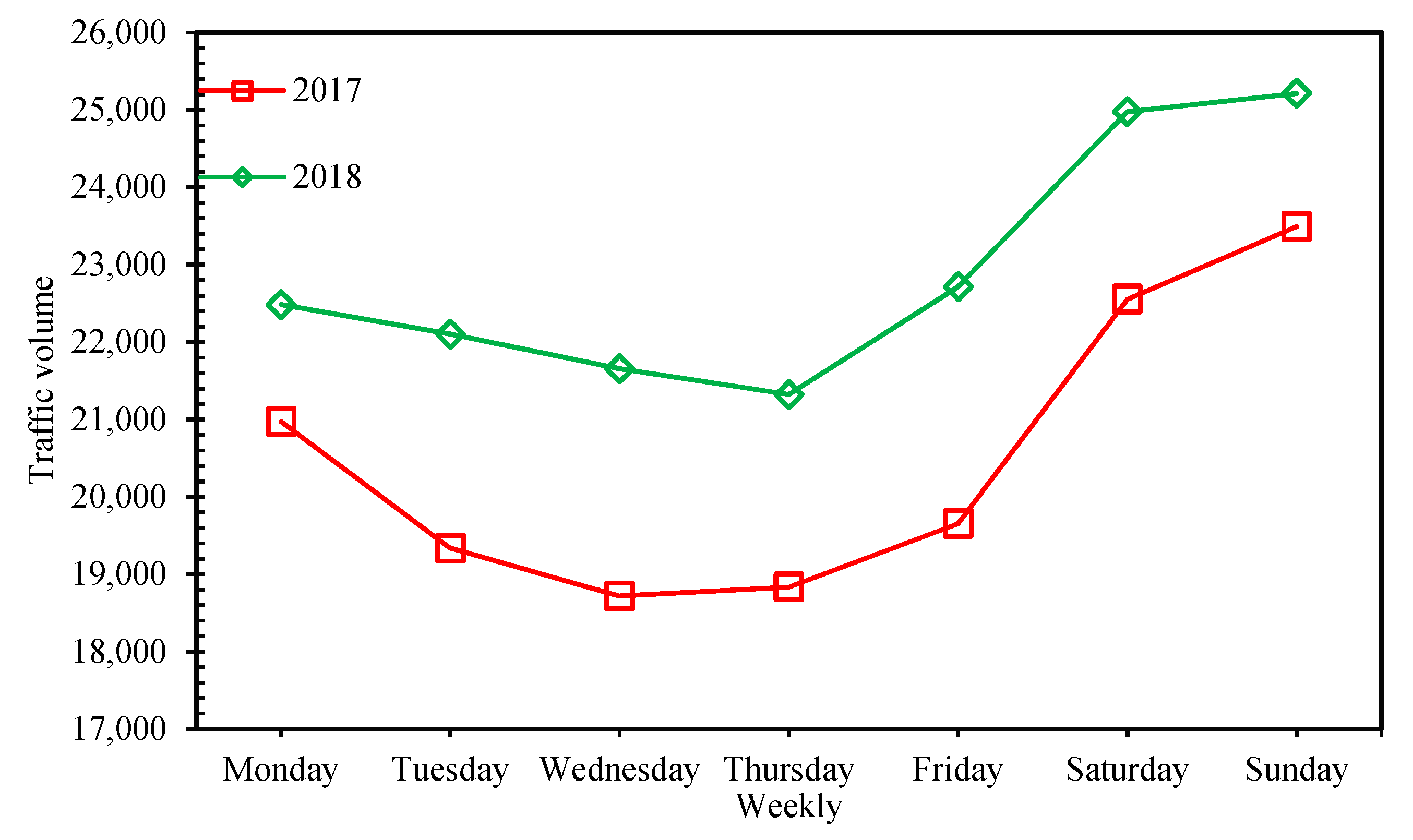




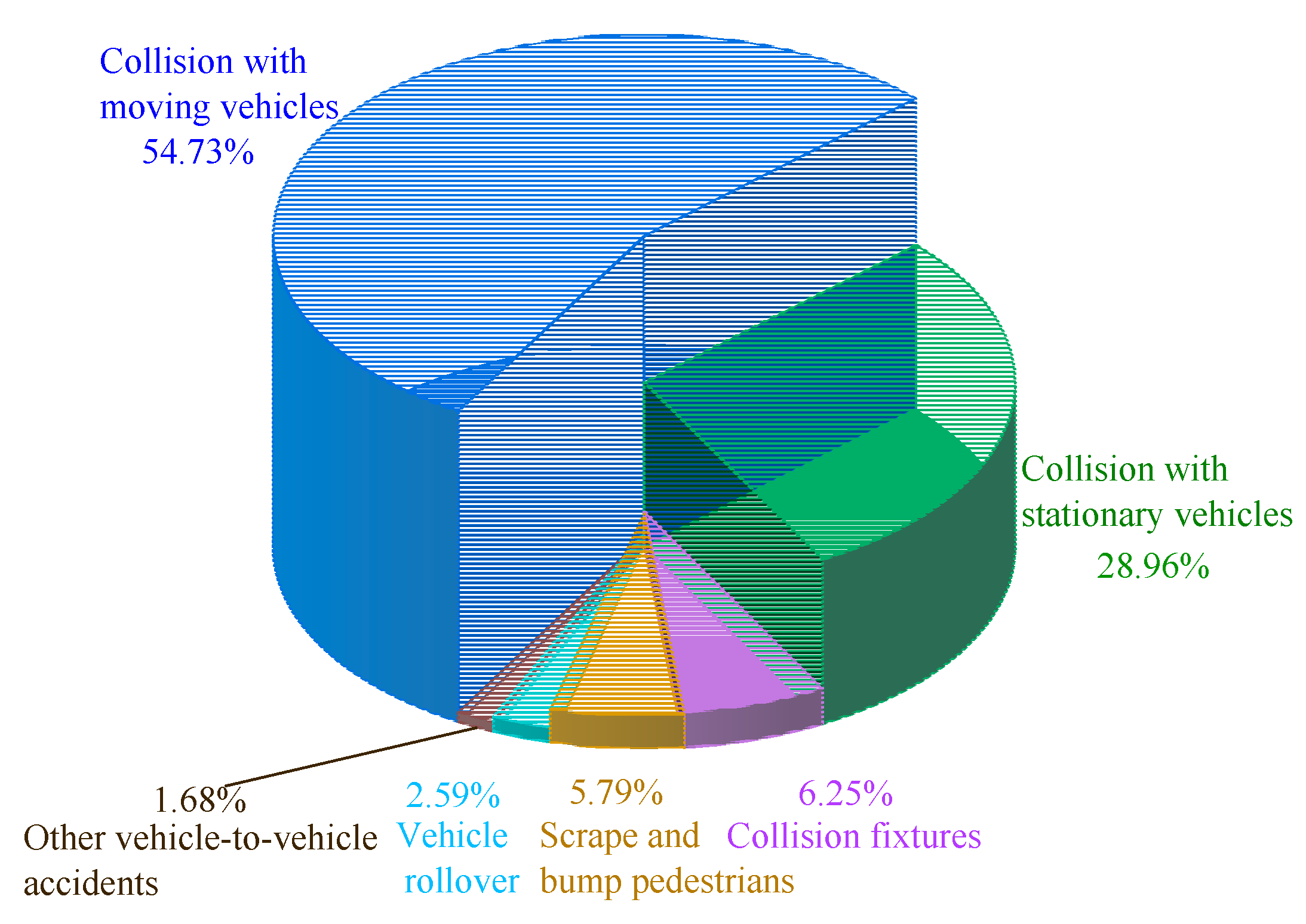
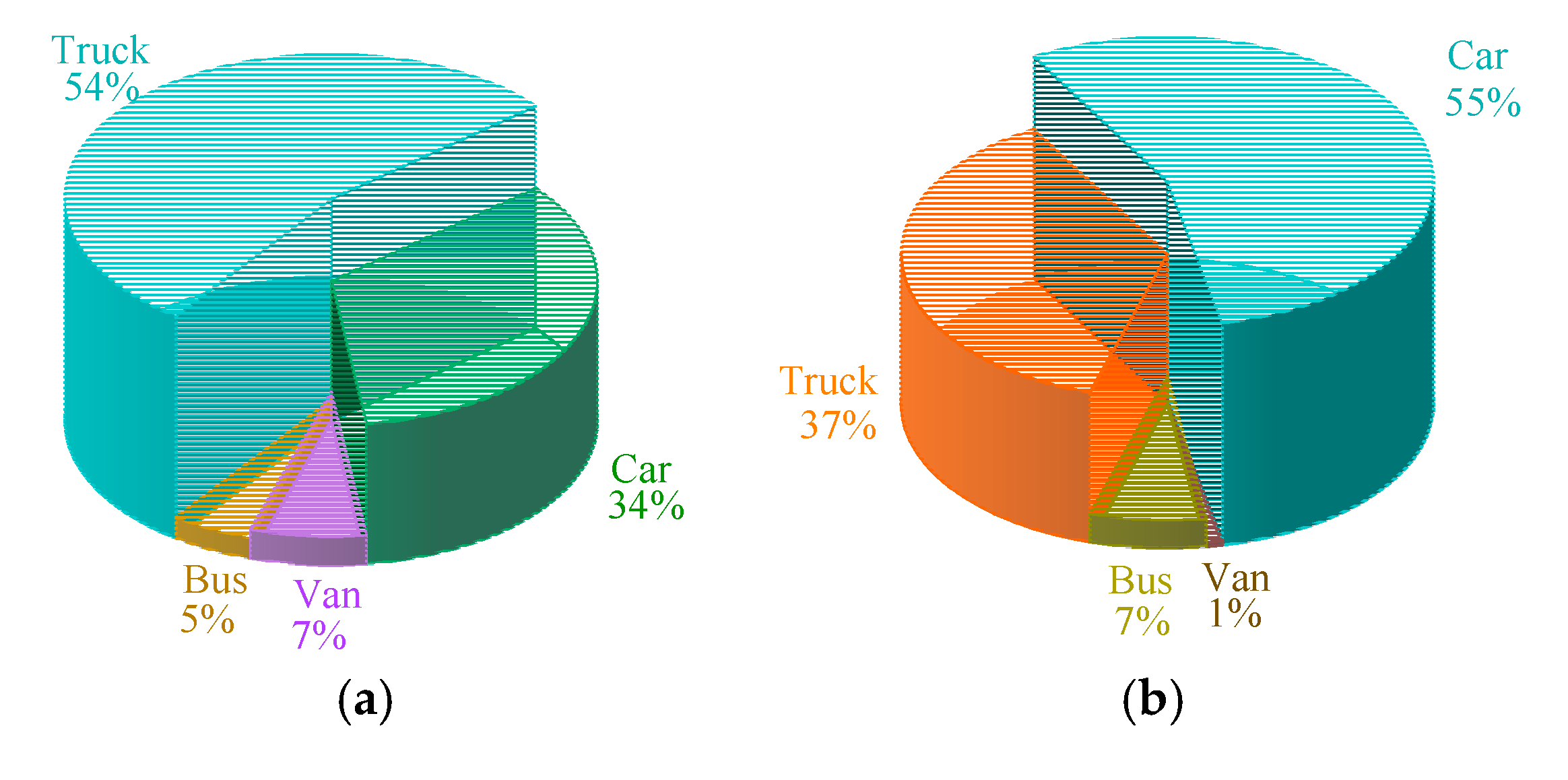
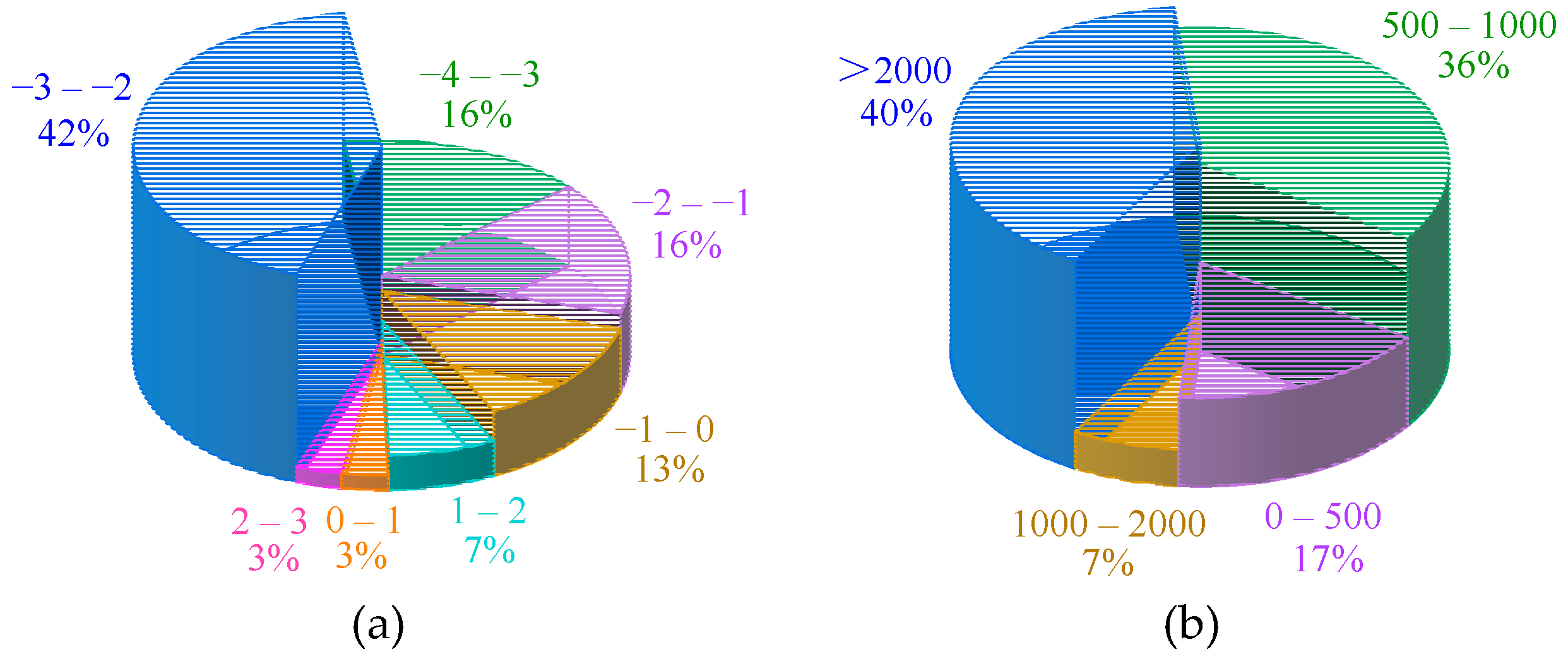
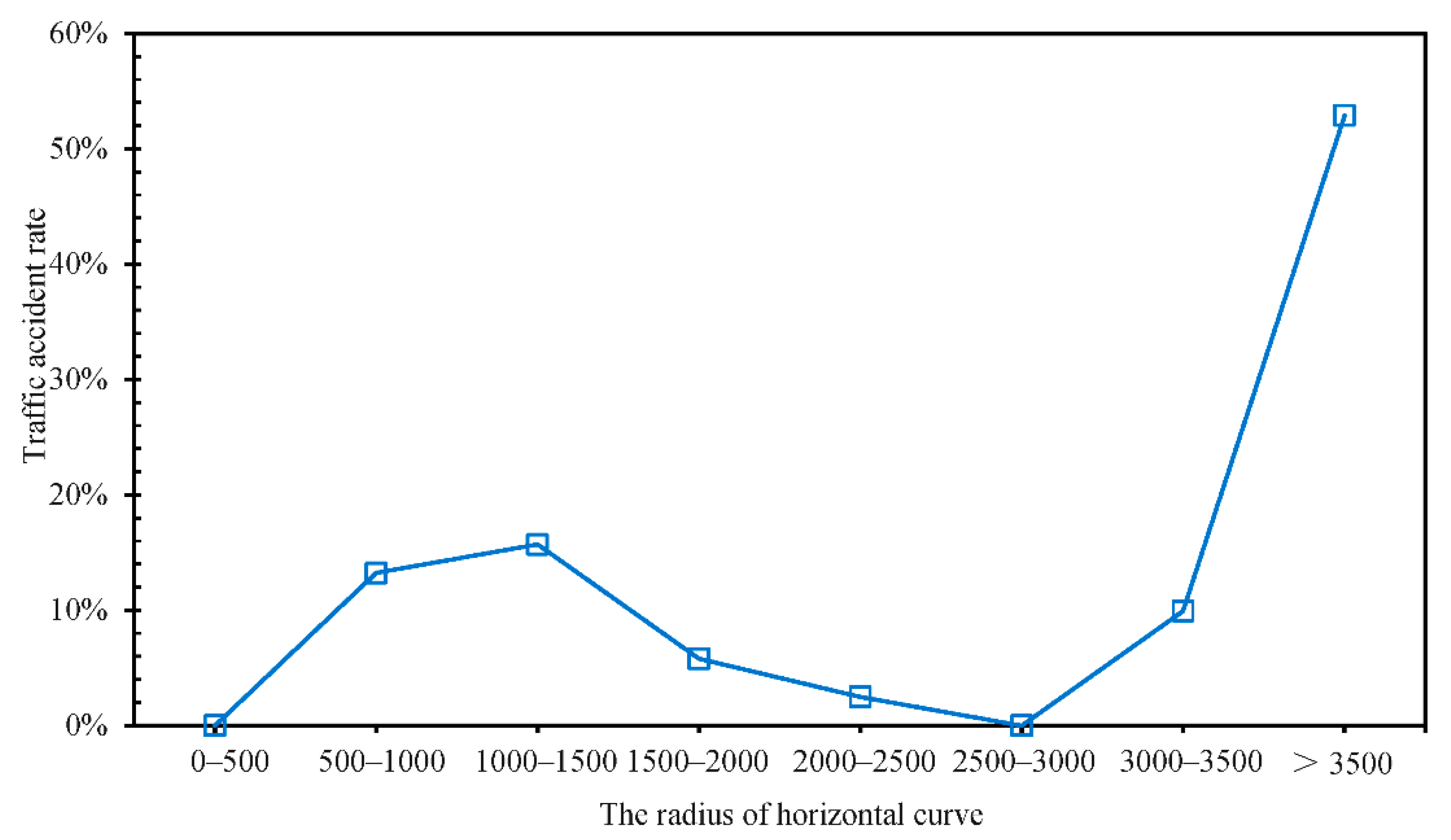
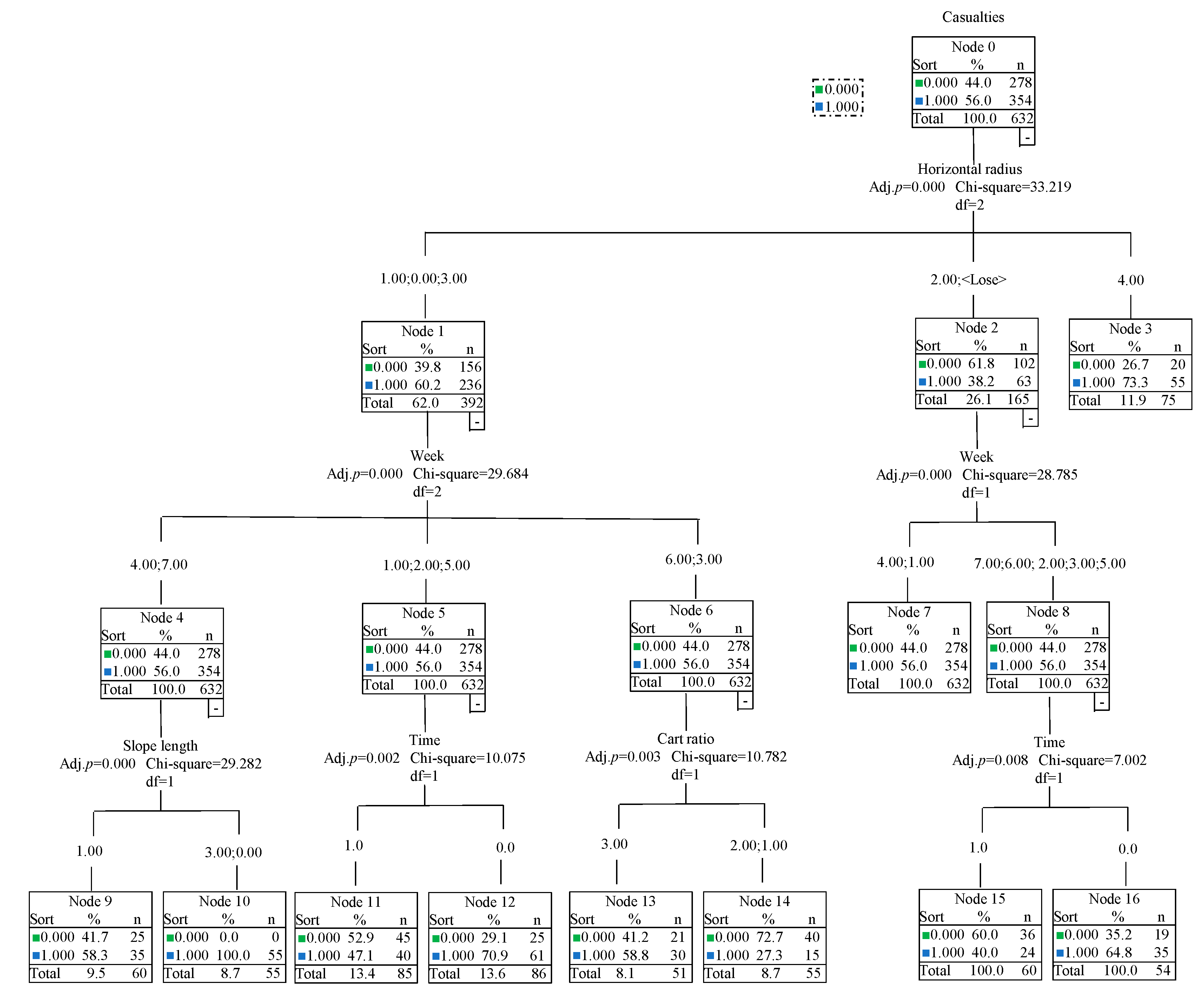
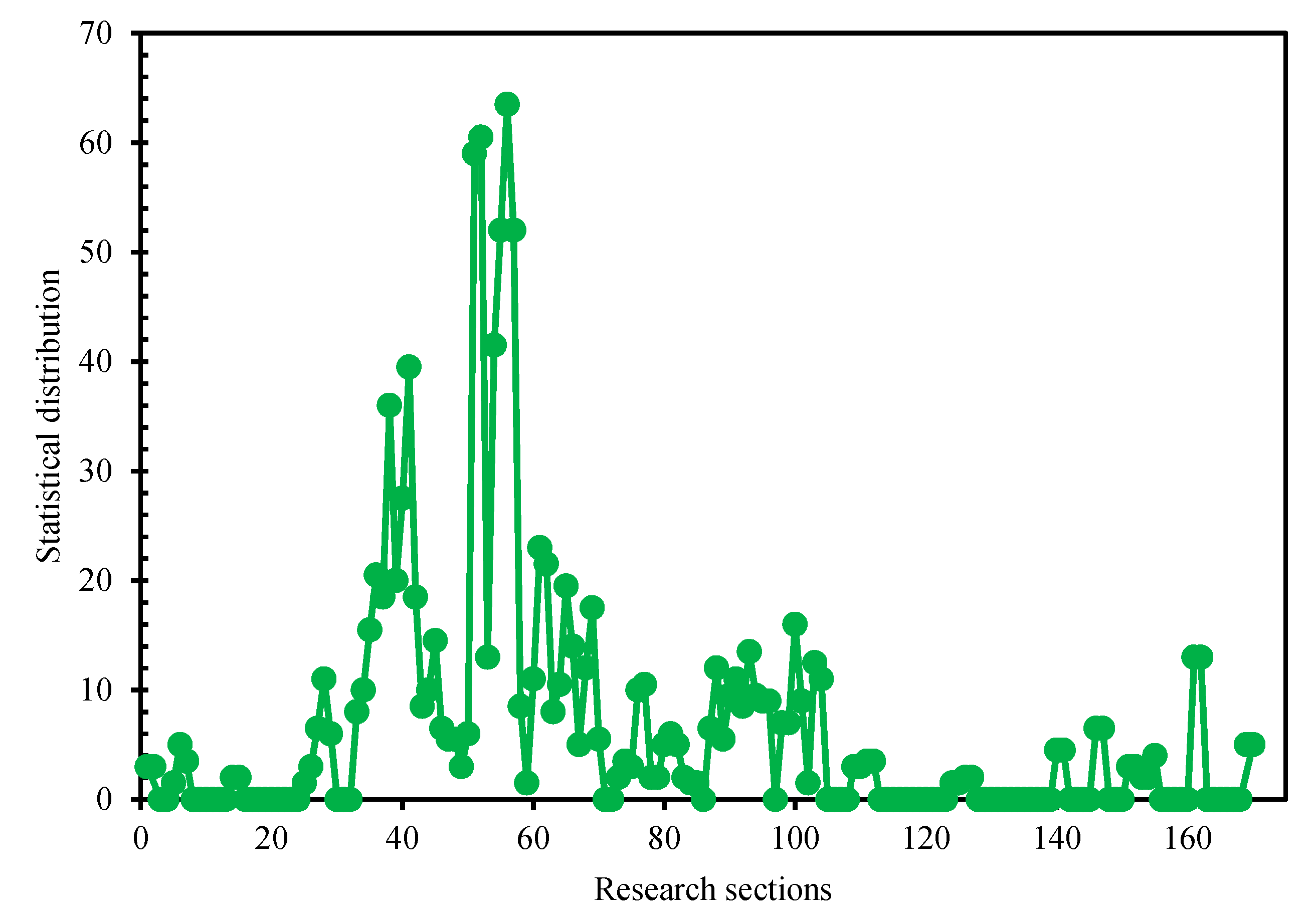
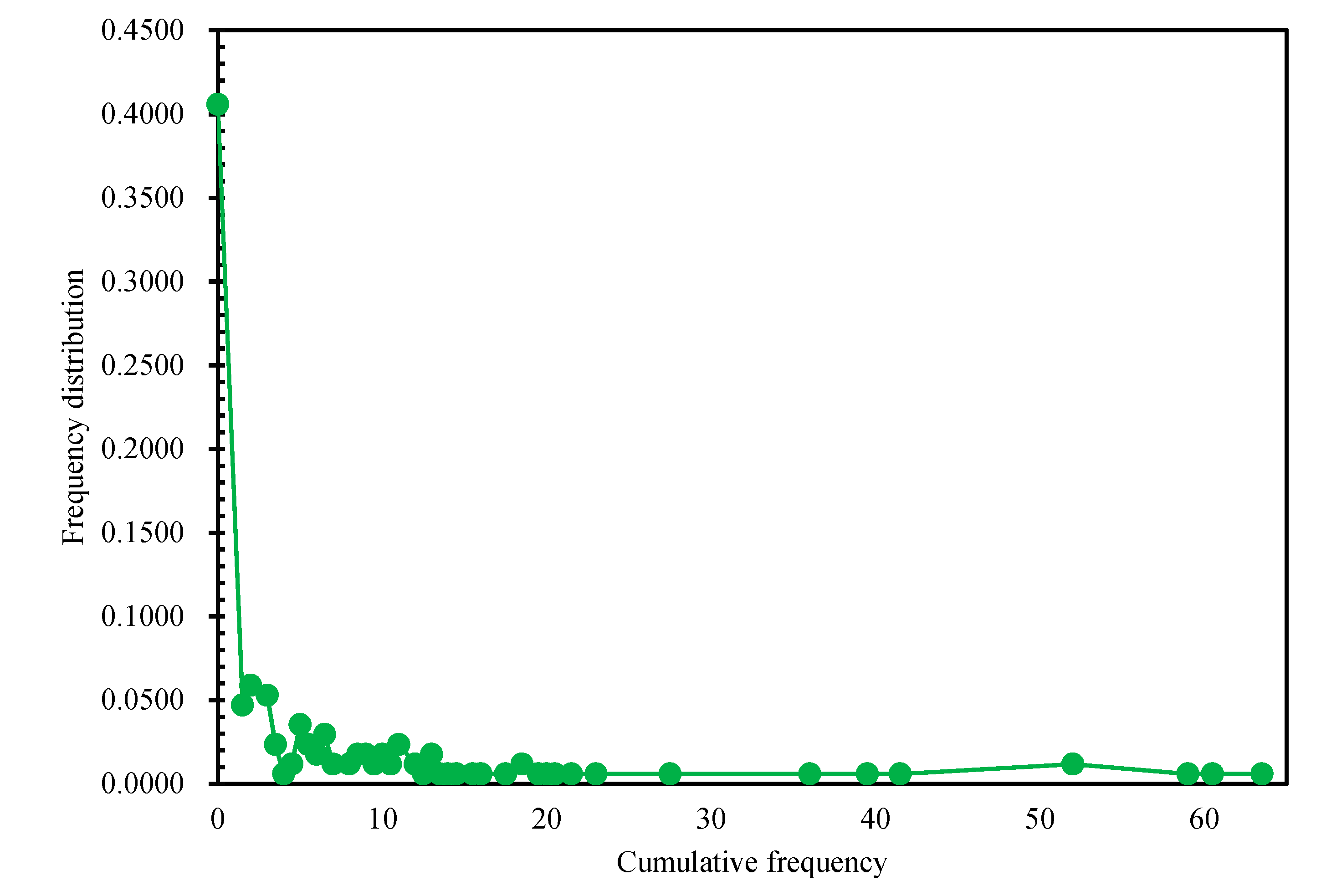
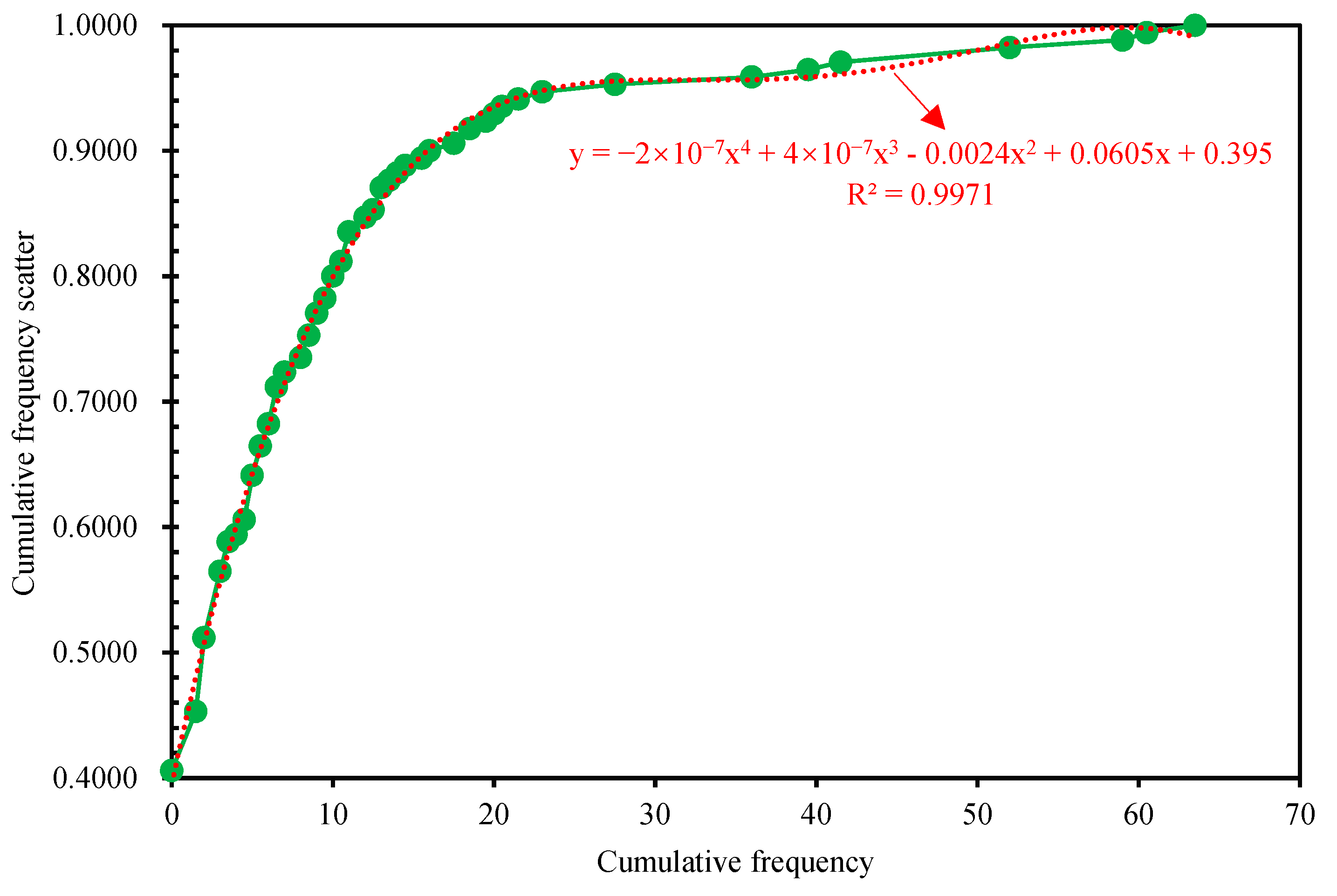
| Controls | The Parameters and Variables Directly Related | Results | Reference |
|---|---|---|---|
| Improved support vector machine approach | Driver’s operating behavior, vehicle driving status, and road traffic environment information | Better classification in specific scenarios on mountain roads | [5] |
| Accident count model and logarithmic change model | Social development and climatic factors | Analysis of factors influencing the frequency of fatal traffic accidents | [11] |
| Support vector machine approach to data mining | The driving environment, road structure, and usage characteristics | Areas where serious accidents are predicted to occur. | [13] |
| Random tree | Age range and drug involvement | A random tree classifier is better in the road accident model based on injury severity. | [16] |
| Association rule mining methods | Weather and accident causes | Accurate warning to improve traffic safety | [18] |
| Multidimensional multi-data type Apriori algorithm for association analysis | Driver, vehicle, road, gas, and time | Analyze road traffic accident history data and realize system decision analysis module. | [19] |
| Decision tree algorithm | Age, season, and gender | The decision tree approach for accident analysis has advantages | [21] |
| Descriptive statistics and cross-tabulation methods | Hourly, weekly, seasonal, and spatial distribution | Precise analysis of the distribution of accident reporting periods | [22] |
| Name | Section 1 | Section 2 | Section 3 | Section 4 | Entire Study Area | |
|---|---|---|---|---|---|---|
| Taipingliang tunnel | Length | 0.20 | 0.20 | 0.60 | 1.12 | 2.12 |
| Accident number | — | — | 6 | 4 | 10 | |
| Accident frequency (times/km) | 0.00 | 0.00 | 10.00 | 3.58 | 13.58 | |
| Tayayi tunnel | Length | 0.20 | 0.20 | 0.42 | — | 0.82 |
| Accident number | 2 | 4 | — | — | 6 | |
| Accident frequency | 10.00 | 20.00 | 0.00 | — | 30.00 | |
| Hanzhang tunnel | Length | 0.20 | 0.20 | 0.60 | 1.65 | 2.65 |
| Accident number | — | — | 2 | 2 | 4 | |
| Accident frequency | 0.00 | 0.00 | 3.33 | 1.21 | 4.55 | |
| Baijiazhuang tunnel | Length | 0.20 | 0.20 | 0.60 | 0.50 | 1.50 |
| Accident number | — | — | 4 | 2 | 6 | |
| Accident frequency | 0.00 | 0.00 | 6.67 | 4.00 | 10.67 | |
| Yuejiagou tunnel | Length | 0.20 | 0.20 | 0.60 | 3.31 | 4.31 |
| Accident number | — | — | — | 12 | 12 | |
| Accident frequency | 0.00 | 0.00 | 0.00 | 3.63 | 3.63 | |
| Zijingguan tunnel I | Length | 0.20 | 0.20 | 0.60 | 3.34 | 4.34 |
| Accident number | 6 | — | 4 | 24 | 34 | |
| Accident frequency | 30.00 | 0.00 | 6.67 | 7.19 | 43.86 | |
| Zijingguan tunnel II | Length | 0.20 | 0.18 | — | — | 0.38 |
| Accident number | 6 | 2 | — | — | 8 | |
| Accident frequency | 30.00 | 11.05 | — | — | 41.05 | |
| Yunmengshan tunnel I | Length | 0.20 | 0.20 | 0.60 | 0.97 | 1.97 |
| Accident number | 8 | — | 14 | 18 | 40 | |
| Accident frequency | 40.00 | 0.00 | 23.33 | 18.52 | 81.85 | |
| Yunmengshan tunnel Ⅱ | Length | 0.20 | 0.20 | 0.35 | — | 0.75 |
| Accident number | — | — | 6 | — | 6 | |
| Accident frequency | 0.00 | 0.00 | 17.05 | — | 17.05 | |
| Yunmengshan tunnel Ⅲ | Length | 0.20 | 0.20 | 0.60 | 1.22 | 2.22 |
| Accident number | 10 | 4 | — | 8 | 22 | |
| Accident frequency | 50.00 | 20.00 | 0.00 | 6.56 | 76.56 | |
| Xiling tunnel | Length | 0.20 | 0.20 | 0.14 | — | 0.54 |
| Accident number | 2 | — | — | — | 2 | |
| Accident frequency | 10.00 | — | — | — | 10.00 | |
| Summary | Length | 2.20 | 2.18 | 5.11 | 12.11 | 21.59 |
| Accident number | 34 | 10 | 36 | 70 | 150 | |
| Accident frequency | 15.45 | 4.59 | 7.05 | 5.78 | 6.95 |
| Variable Set Properties | Variable Description |
|---|---|
| Time of accident | Day = 0, Night = 1 |
| Weather | Sunny = 0, Non sunny = 1 |
| Temperature | −10–0 °C = 0, 0–10 °C = 1, 10–20 °C = 2, 20–30 °C = 3 30–40 °C = 4 |
| Wind direction | North wind = 0, Northeast wind = 1, East wind = 2, Southeast wind = 3, South wind = 4, Northwest wind = 5, West wind = 6, Southwest wind = 7 |
| Wind power | ≤3 level = 0, 3–4 level = 1, 4–5 level = 2 |
| Slope length | 0–500 m = 0, 500–1000 m = 1, 1000–2000 m = 2, >2000 m = 3 |
| Slope | −4–−3% = 0,−3–−2% = 1, −2–−1% = 2, −1–0% = 3, 0–1% = 4, 1–2% = 5, 2–3% = 6 |
| Super elevation | 2% = 0,3% = 1, 4% = 2, 5% = 3 |
| Horizontal curve radius | R is ∞ = 0, 500–1000 = 1, 1000–2000 = 2, 2000–3000 = 3, >3000 = 4 |
| Rate of heavy vehicle | 0.1–0.2 = 0, 0.2–0.3 = 1, 0.3–0.4 = 2, 0.4–0.5 = 3, >0.5 = 4 |
Publisher’s Note: MDPI stays neutral with regard to jurisdictional claims in published maps and institutional affiliations. |
© 2022 by the authors. Licensee MDPI, Basel, Switzerland. This article is an open access article distributed under the terms and conditions of the Creative Commons Attribution (CC BY) license (https://creativecommons.org/licenses/by/4.0/).
Share and Cite
Wang, F.; Wang, J.; Zhang, X.; Gu, D.; Yang, Y.; Zhu, H. Analysis of the Causes of Traffic Accidents and Identification of Accident-Prone Points in Long Downhill Tunnel of Mountain Expressways Based on Data Mining. Sustainability 2022, 14, 8460. https://doi.org/10.3390/su14148460
Wang F, Wang J, Zhang X, Gu D, Yang Y, Zhu H. Analysis of the Causes of Traffic Accidents and Identification of Accident-Prone Points in Long Downhill Tunnel of Mountain Expressways Based on Data Mining. Sustainability. 2022; 14(14):8460. https://doi.org/10.3390/su14148460
Chicago/Turabian StyleWang, Fu, Jing Wang, Xianfeng Zhang, Dengjun Gu, Yang Yang, and Hongbin Zhu. 2022. "Analysis of the Causes of Traffic Accidents and Identification of Accident-Prone Points in Long Downhill Tunnel of Mountain Expressways Based on Data Mining" Sustainability 14, no. 14: 8460. https://doi.org/10.3390/su14148460
APA StyleWang, F., Wang, J., Zhang, X., Gu, D., Yang, Y., & Zhu, H. (2022). Analysis of the Causes of Traffic Accidents and Identification of Accident-Prone Points in Long Downhill Tunnel of Mountain Expressways Based on Data Mining. Sustainability, 14(14), 8460. https://doi.org/10.3390/su14148460







